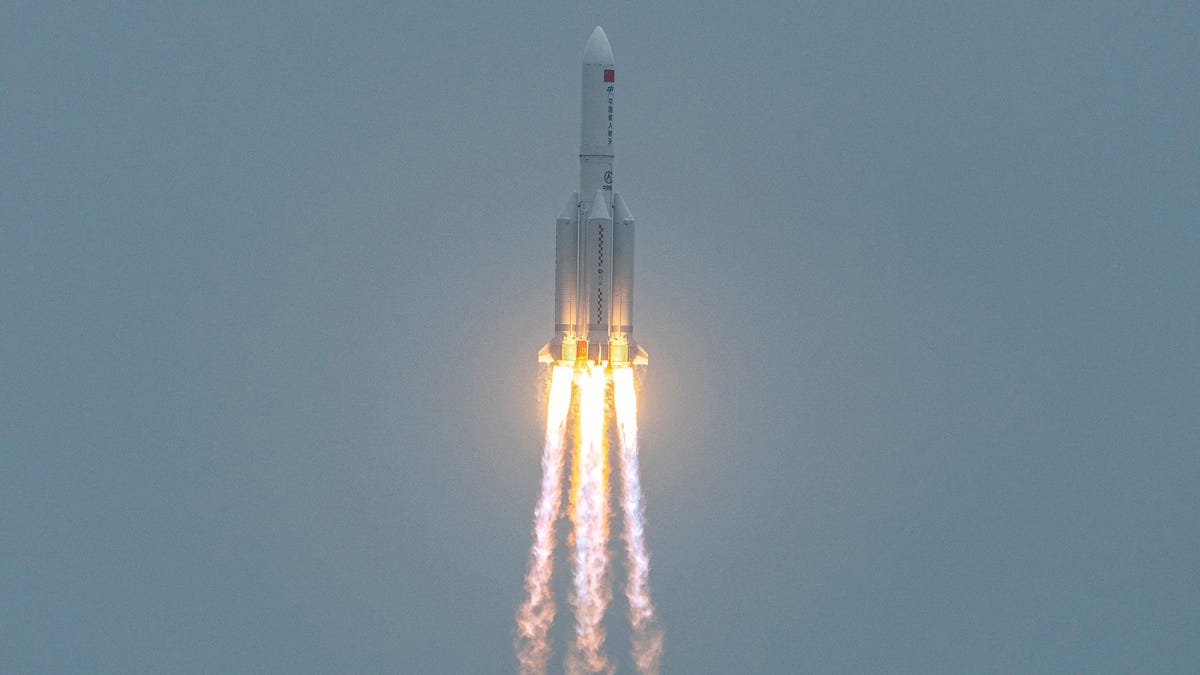Could An Uncontrolled Rocket Re-Entry Kill a Human? Scientists Just Did The Math
According to these calculations, there's a 10% chance a human might get hit with debris over the next decade.

A Chinese Long March 5B rocket departs for space
Just prior to re-entering Earth's atmosphere in early May 2021 the SpaceX Crew Dragon, Resilience, jettisoned its trunk to reduce mass and save propellant prior to a deorbit burn. The discarded Dragon detritus then solemnly circled the Earth for months, slowly being dragged toward its cataclysmic end: Burning up in the atmosphere.
Last week, death came for the trunk. Residents in south-east Australia were treated to a magical sky show as it finally plummeted through the atmosphere, blazing across a dusky sky. It's unclear whether it completely burned up or if pieces of it made their way to the ground.
Nevertheless, Resilience posed no threat to human life (that we know of). It was a slightly different story for the Long March 5B rocket China launched in April 2021. For a long while, it was unclear exactly where that discarded rocket body would end up, with scientists scrambling to plot its trajectory. Fortunately, it landed safely in the ocean, not far from the Maldives.
Perhaps we got lucky. There is a risk that a discarded rocket body might one day fall on our heads. It's a very, very tiny risk: Researchers have estimated the chances are less than one in a billion. But the risk one of these pieces hits somebody, somewhere at some point in the next 10 years? Well, that's a little higher, according to research published on July 11 in Nature Astronomy.
A team of Canadian researchers analyzed three decades of satellite data to assess the risk posed to human life by an uncontrolled rocket re-entry. In that time, more than 1,500 rocket bodies returned to Earth, and about 70% of them did so in an uncontrolled manner, according to the research.
The team's analyses settle on a slightly concerning figure: There's about a 10% chance of one or more human casualties over the next decade.
SpaceX's Crew Dragon. The spacecraft discards its trunk before heading back to Earth.
There are, of course, some limitations to the study. As an approximation it works well, but there are some generalizations about population density at latitude, which rocket bodies will threaten humans in the next decade, how much re-entry debris spreads out and the definition of "uncontrolled." It should also be noted the risk isn't an individual risk. You can go about your day just fine without checking the weather forecast for Rocket Rain each morning because this isn't an individual risk.
But launch cadence is increasing. We're sending up more rockets than ever before: In 2021, there were 145 launch attempts (10 were failures), an increase of almost 30% over 2020. The researchers note that more than 60% of the launches in 2020 resulted in an abandoned rocket body. So… there's a lot going up that will, eventually, come down.
And where the bodies fall is not always easy to predict.
"[T]he models we use to predict where things will go are imperfect because there are so many variables in play," says Mars Buttfield-Addison, a PhD student at the University of Tasmania and Australia's CSIRO researching ways to track satellites with radio telescopes who was not affiliated with the study.
Notably, the falls also occur disproportionately across the world. The team writes there's a "significantly higher" risk in states of the Global South compared to the major spacefaring nations launching rockets, like the US and Russia. For instance, someone in Jakarta, Indonesia, is three times as likely as someone in New York to have a rocket body re-enter over their heads.
This comes down to where rockets are launched from and, thus, where the discarded bodies orbit. Many launches occur close to the equator because Earth's spin essentially gives a speed boost, which makes it cheaper, but it clutters up the orbit.
The take-home message from the report is that we – governments, in particular – should be thinking about rocket re-entries before they get blasted off into space. The team says allowing rocket bodies to come back to Earth in an uncontrolled manner is "increasingly becoming a choice rather than a technological limitation." It comes down to cost.
In a nutshell, those organizations launching rockets should be able to control how they come back to Earth and guide them safely into a remote area of the ocean. The suggestion is launch providers would need to upgrade their rockets so they can be controlled on their descent or they will need to alter mission designs, putting extra fuel onboard so it can be used to steer the reentry. However, they note this will incur extra costs and that doesn't always vibe with the big space organizations trying to get things in orbit.
What can be done? The researchers write that every launching state must adopt solutions to control re-entering rockets. They point to the Montreal Protocol, which saw UN member states limit the use of chlorofluorocarbons after scientists demonstrated they were damaging the ozone layer. The suggestion is that states of the Global South, which are most at risk, might be able to put pressure on spacefaring nations to mandate for controlled reentries.
Buttfield-Addison echoes those sentiments. "Regulation before launch is key," she says, "because once something's coming down there's very little we can do."

